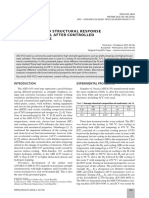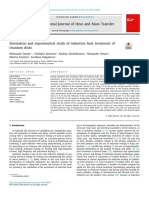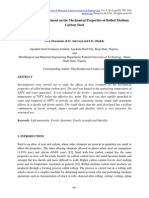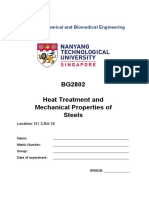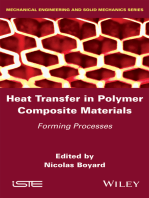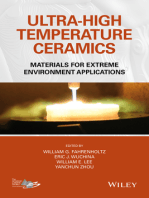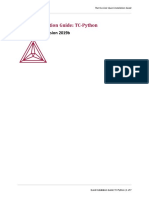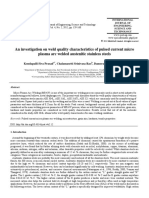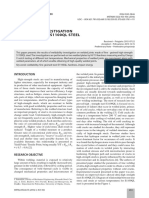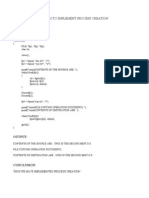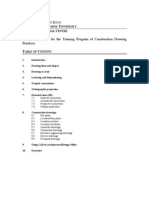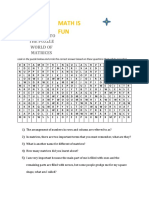Dilatometric and Hardness Analysis of C45 Steel Tempering With Different Heating-Up Rates
Dilatometric and Hardness Analysis of C45 Steel Tempering With Different Heating-Up Rates
Uploaded by
InaamCopyright:
Available Formats
Dilatometric and Hardness Analysis of C45 Steel Tempering With Different Heating-Up Rates
Dilatometric and Hardness Analysis of C45 Steel Tempering With Different Heating-Up Rates
Uploaded by
InaamOriginal Description:
Original Title
Copyright
Available Formats
Share this document
Did you find this document useful?
Is this content inappropriate?
Copyright:
Available Formats
Dilatometric and Hardness Analysis of C45 Steel Tempering With Different Heating-Up Rates
Dilatometric and Hardness Analysis of C45 Steel Tempering With Different Heating-Up Rates
Uploaded by
InaamCopyright:
Available Formats
J. WINCZEK, A.
KULAWIK ISSN 0543-5846
METABK 51(1) 9-12 (2012)
UDC – UDK 669.14-418:539.37:620.17=111
DILATOMETRIC AND HARDNESS ANALYSIS OF C45 STEEL
TEMPERING WITH DIFFERENT HEATING-UP RATES
Received – Prispjelo: 2010-09-20
Accepted – Prihvaćeno: 2011-02-10
Original scientific paper – Izvorni znanstveni rad
Modelling of technological processes of heat treatment or welding, involving multiple heat source transitions, re-
quires considering the phenomenon of tempering. In work have been presented results of dilatometric research of
hardened C45 steel subjected to tempering. The analysis of the influence of heating rate at the kinetic determined
from dilatometric curves has been made. There have also been estimated quantities of transformation expansions
and thermal expansion coefficients of hardening and tempering structures (austenite, ferrite, pearlite, martensite
and sorbite). The analysis of tempering time influence on the hardness of tempered steel has been made. Functions
associating hardness with tempering time (rate of heating-up) in technological processes based on short-timed ac-
tion of a heat source (eg. laser treatment) have been suggested.
Key words: dilatometric analysis, hardness, tempering, heat treatment, mechanical properties
Dilatrometrijska i analiza tvrdoće čelika C45 popuštanog uz različite brzine zagrijavanja. Modeliranje tehno-
loškog procesa toplinske obrade ili zagrijavanja, uključivo višedjelne izvore prijelaza topline, zahtijeva razmatranje
fenomena toplinske obrade popuštanje. U radu su prezentirani rezultati popuštanja tvrdoće zakaljenog čelika C45.
Analiza utjecaja brzine zagrijavanja na kinetiku procesa je determinirana dilatometrijskim krivuljama. Procijenjeni
su kvantitativni transformacijski izrazi i koeficijent toplinskog širenja kaljenih i propuštenih struktura (austenit, per-
lit, mertenzit, sorbit). Napravljena je analiza utjecaja trajanja popuštanja na tvrdoću popuštenog čelika. Preporuče-
na je funkcija koja udružuje tvrdoću i trajanje propuštanja (brzina zagrijavanja) u tehnološkom procesu temeljena
na kratkotrajnom djelovanju izvora topline (npr. tretman laserom).
Ključne riječi: dilatometrijska analiza, tvrdoća, popuštanje, toplinska obrada, mehanička svojstva
INTRODUCTION concern comparative metallographic analysis and me-
chanical properties before and after the tempering [2-7].
In technological processes of heat treatment and While in modelling of stress states during tempering,
welding, depending on steel genre and process param- the influence of phase changes is frequently omitted [8].
eters, can occur quenching structures, including marten- In the case of heat treatment the time of heating-up
site. In case of process connected with multiple laser amounts to several dozen minutes, while annealing can
beam transitions or welding electrode making next last even hours. The result is homogenous tempering
welds cause tempering of already hardened areas. Most structure. For such technological conditions, detailed
frequently, initial heating-up of heat-treated material analysis of changes in microstructure in steel C45 and
above MS temperature of the beginning of martensitic Ni3.5CrMoV has been presented in work [9]. In weld-
transformation during cooling, is used in order to pre- ing processes and laser treatment occurs dynamic tem-
vent creation of austenite during to prevent creation of perature change, while time of peak tempearture during
austenite during technolo-gical process. In other case it tempering lasts from several to hundreds of seconds.
is essential to take into consideration tempering. In the Short austenisation time, as well as of tempering lead to
case of welding processes in order to obtain appropriate heterogeneous structure. Work [10] examines the micro-
final structure, temper bead application is used [1]. In structure and hardness after multiple welding cycles,
order to project final structure of the material after the while in work [11] have been presented results of metal-
process or to calculate strain and stress state in heat- lographic research, microhardness and impact strength
treated object it is essential to have the knowledge in of welds tempered by conventional method. The authors
kinetics of phase changes tempering. A lot of works [12] carried out analysis of tempering kinetics of weld-
have been dedicated to examine the phenomenon of ed elements basing on results of microhardness meas-
tempering. In most of them carried out experiments urements. There is lack of works describing quantita-
tively the connection between strains and temperature
J. Winczek, A. Kulawik, Faculty of Mechanical Engineering and Com-
puter Science, Czestochowa University of Technology, Czestochowa, during welding and laser processes. The speed of heat-
Poland ing-up can significantly affect kinetics of heating-up
METALURGIJA 51 (2012) 1, 9-12 9
J. WINCZEK et al.: DILATOMETRIC AND HARDNESS ANALYSIS OF C45 STEEL TEMPERING WITH DIFFERENT...
transformations in steel both during austenitisation [13-
16], as well as during heating-up from hardened stage
(of tempering) [17,18].
TEMPERING IN STEELS
In conventional heat treatment process in steels with
the carbon content up to 0,2 wt.% tempering begins al-
ready in the environment temperature moving coal atoms
[19]. After that segregation from temperature 80 0C oc-
curs liberating of carbides – it proceeds most intensively
in the temperature range between 150 – 200 0C, ends
mainly at 250 0C, but sometimes at 400 0C. As a result of
reducing the amount of coal, tetragonality of martensite
is decreasing. Created in the first phase of tempering
structure, consisting of supersaturated solid solution α Figure 1 Thermal Cycle Simulator Smitweld 1405
and carbide ε is called low-tempered martensite.
Between 100 and 350 0C any retained austenite be-
gins to decompose. It has been suggested that this hap-
pens by transformation into bainitic ferrite and cement-
ite [19]. Above 350 0C martensite decomposes liberat-
ing cement grains creating the phase called sorbite or
troostite. Then the growth of grains occurs and coagula-
tion of cementite particles, spheroidizing, i.e. forming
tiny spherical particles of cementite in ferrite matrix.
Tempering process ends in the temperature range 600
- 700 0C. Above 600 0C still proceeds coagulation of ce-
mentite and spheroidizing of ferrite – formation of di-
vorced pearlite, i.e. globular cementite in ferrite matrix of
low hardness. This stage is called recrystallization.
Figure 2 Martensitic structure of a hardened sample
EXPERIMENTAL WORK
The chemical composition of researched steel is Table 2 Average temperature values Ts and Tf
shown in Table 1. VH / 0C/s 0,1 0,5 1 2 5 10
Table 1 Chemical composition of C45 steel substrates wt. Ts / 0C 290 300 310 315 320 325
% (max.) Tf / 0C 420 430 435 440 450 465
C Mn Si P S Al Cr Ni Mo Cu VH / 0C/s 20 30 40 50 60 100
0,44 0,660 0,250 0,015 0,024 0,017 0,011 0,10 0,025 0,24 Ts / 0C 335 340 345 350 355 370
Tf / 0C 470 475 480 485 490 500
Dilatometric experiments were carried out in ther-
mal cycle simulator Smitweld TCS1405 (Figure 1). The
influence of the speed of heating-up on the temperature 1200
of the beginning and the end of tempering has been re-
1100
searched for the speed of heating from 0,1 to 100 0C/s.
Samples for tempering research have been heated-up to 1000
1100 0C, then cooled with the velocity 200 0C/s. Mar- 900
tensitic structure of hardened sample is presented in
Temperature / 0C
800
Figure 2. The average value of hardness of hardened 700
area was HV30 = 714.
600
For each speed of heating have been made at least 3
dilatometric researches which allowed to determine 500
temperature average values Ts of the beginning and Tf of 400
10 / 0C
the end of tempering process. Average values have been 300
presented in Table 2. 200 Hardening
Dilatometric graph for hardening-tempering cycle with 100 Tempering
the heating-up with the velocity VH = 10 0C/s during tem-
0
pering has been presented in Figure 3. From the analysis of
dilatometric graphs, we can draw a conclusion that the first -0,004 0 0,004 0,008 0,012 0,016 0,02
stage of tempering – the segregation of coal atoms and Dilatation / m-3
liberating carbides (to 290 0C) do not affect significantly Figure 3 Dilatometric curves for hardening-tempering cycle
10 METALURGIJA 51 (2012) 1, 9-12
J. WINCZEK et al.: DILATOMETRIC AND HARDNESS ANALYSIS OF C45 STEEL TEMPERING WITH DIFFERENT...
the shape of dilatometric curve. Distinct changes on dilato- Table 3 Structural (γ) and thermal (α) expansion
metric graphs have been observed in the temperature range coefficients for phase of C45 steel.
290 - 500 0C, during forming of sorbite. α / 1/°C
The dependence of temperature Ts on the heating Austenite 2,178⋅10-5 γF,P,S→A 1,986⋅→10-3
rate V(H) (Figure 4) has been determined by approxi- Ferrite 1,534⋅10-5 γB→A 1,440⋅10-3
mation of dilatometric measure-ments by Hoerl regres- Pearlite 1,534⋅→10 -5
γA→F,P 3,055⋅10-3
sion model using program CurveExpert [20]:
Bainite 1,171⋅→10-5 γA→B 4,0⋅10-3
Ts (VH ) = abVH (VH )
c (1)
Martensite 1,36⋅→10 -5
γA→M 6,85⋅→10-3
where: a = 306,16454, b = 1,0007254, c = 0,025137007, Sorbite 1,534⋅→10-5 γM→S 1,0⋅10-3
correlation coefficient is 0,997, while standard error
2,137.
700
In a similar way has been determined the depend- VH = 100 20 5 2 0.5 0.1
650
ence of temperature Tf on the heating rate V(H) (Figure
4) using Harris regression model: 600
550
1
T f (VH ) = (2) 500
Temperature / 0C
a + bVHC 450 Tf
where: a = 0,00258774, b = -0,00028544502, c = 400
0,15680145, correlation coefficient 0,999, standard er- 350
ror 1,259. 300
Ts
The CHT (Continuous Heating Transfor-mations)
250
diagram is presented in Figure 5.
200
On the basis of dilatometric measurements and re-
150
sults of works [21] have been determined thermal ex-
pansion coefficients and transformation expansions val- 100
ues which are shown in Table. 3. 50
Results of hardness measurement of samples after 0,01 0,1 1 10 100 1000 10000
tempering have been presented in Table 4. Together Time / s
with the decrease of tempering time (increase of heat-
Figure 5 CHT diagram of C45 steel
ing-up rate with constant cooling velocity 10 0C/s in
thermal cycles) diminishes hardness. Table 4 Average hardness values for different rates of
For carried out researches, the dependence of hard- heating-up (tempering times)
ness on rate of heating-up has been approximated with VH / 0C/s 0,1 0,5 1 2 5 10
function (Figure 6): time / s 7070 1470 770 420 210 140
HV30 (VH ) = aVH4 + bVH3 + cVH2 + dVH + e (3) HV30 340 343 346 349 353 360
VH / 0C/s 20 30 40 50 60 100
where: a = -2,4578808x10-6, b = 0,00054318, c = - time / s 105 93,33 87,5 84 81,66 77
0,030563, d = 2,0558168, e = 342,63333, correlation HV30 375 389 405 422 441 540
coefficient 0,999, standard error 1,608.
The influence of tempering time t on hardness has
550 been determined by functions (Figure 7):
- for t <= 100 s
c
500
HV30(t ) = a + bt + 2 (4)
t
where: a = 375,85089, b = -23065,856, c = 0,1459668,
correlation coefficient 0,999, standard error 3,2,
Temperature / 0C
450
model Tf
model Ts - for t > 100 s
a (5)
400 experiment HV30(t) =
1 + b exp(−ct )
where: a = 344,95107, b = -0,0070576689, c = 357598,
350
correlation coefficient 0,992, standard error 2,523.
300 CONCLUSIONS
In work has been made analysis of influence of the
250 heating-up rate on tempering kinetics. On the basis of
0 10 20 30 40 50 60 70 80 90 100 dilatometric graphs has been proposed the function
VH / 0C/s bounding the rate of heating-up with the temperature of
the beginning and the end of temperature of the begin-
Figure 4 Comparison of Ts(VH) and Tf(VH) models and research ning and the end of transformation expansions during
results tempering phase changes. Quantities of transformation
METALURGIJA 51 (2012) 1, 9-12 11
J. WINCZEK et al.: DILATOMETRIC AND HARDNESS ANALYSIS OF C45 STEEL TEMPERING WITH DIFFERENT...
[3] M. Gojic, L. Kosec, P. Matkovic, The effect of tempering
540
temperature on mechanical properties and microstructure of
530
520 low alloy Cr and CrMo steel, J. Mat. Sci. 33 (1998) 395-
510 403
500 [4] I. Tkalcec, C. Azcoıtia, S. Crevoiserat, D. Mari, Tempering
490 effects on a martensitic high carbon steel, Mat. Sci. Eng. A
480 387–389 (2004) 352–356
Hardness / HV30
470
[5] I. Tkalcec I., Mechamical properties and microstructure of a
460
450 model high carbon steel, PhD Thesis No 3089, Ecole Polytechni-
440 experiment que Federale de Lausanne, 2004, pp. 75-85
430 [6] L.W. Shyan, D.T. Tian, Mechanical and microstructural fea-
420 tu-res of AISI 4340 high-strength alloy steel under quenched
410 and tempered conditions, J. Mat. Proc. Techn. 87 (1999)
400
390
198-206
380 [7] A.K. Lis, Mechanical properties and microstructure of
370 ULCB steels affected by thermomechanical rolling, quen-
360 ching and tempering, J. Mat. Proc. Techn. 106 (2000) 212-
350 218
340 [8] V.I. Kostylev, B.Z. Margolin, Determination of residual
0,2
0,3
0,5
2
3
5
20
30
50 stress and strain fields caused by cladding and tempering of
0,1
10
100
reactor pressure vessels, Press. Vess. Pipp., 77 (2000) 723-
VH / 0C/s 735
[9] Shi Wei, Yao Ke-fu, Chen Nan, Wang Hong-peng, Experi-
Figure 6 Influnce rate of heating-up of tempering on hardness mental study of microstructure evolution during tempering
of quenched steel and its application, Proceedings of the 14-
540 th IFHTSE Congress, Trans. Mat. Heat Treatment, 2004
530
520
(25) 5, 736-739
510 [10] A.S. Oddy, J.M.J. McDill, Numerical prediction of micro-
500 structure and hardness in multicycle simulations, J. Mat.
490 Eng. Perf. 1996 (5) 3, 365-372
480 [11] R.K. Shiue, K.C. Lan, C. Chen C., Toughness and austenite
Hardness / HV30
470 model
460 stability of modified 9Cr-1Mo welds after tempering, Mat.
450 experiment Sci. Eng. A287 (2000) 10-16
440 [12] M. Vijayalakshmi, S. Saroja, R. Mythili, V.Y. Paul, V.S. Ra-
430 ghunathan, Mechanism and kinetics of tempering in weld-
420
410
ments of 9Cr-1Mo steel, J. Nucl. Mat. 279 (2000) 293-300
400 [13] W. Piekarska, Analiza numeryczna zjawisk termomecha-
390 nicznych procesu spawania laserowego. Pola temperatu-
380 ry, przemiany fazowe i naprężenia. Monografie nr 135,
370 Politechnika Częstochowska, Częstochowa 2007
360
350 [14] J.W. Elmer, T.A. Palmer, W. Zhang, B Wood , T. DebRoy,
340 Kinetic modeling of phase transformations occurring in the
330 HAZ of C-Mn welds based on direct observations, Acta Ma-
terial., 51 (2003) 3333-3349.
200
400
600
800
2000
4000
80
6000
[15] A. Danon, C, Servant, A. Alamo, J.C. Brachet, Heteroge-
100
1000
neous austenite grain growth in 9Cr martensitic steels: in-
Time of tempering / s fluence of the heating rate and the austenitization temperatu-
re, Mat. Sci. Eng. A348, 2003, 122-132
Figure 7 Influnce time of tempering on hardness. [16] T. Miokovic, J. Schwarzer, V. Schulze, O. Vöhringer, D.
Löhe, Description of short time phase transformations du-
expansions and thermal expansion coefficients of hard- ring the heating of steels based on high-rate experimental
ening and tempering structures have been estimated. data, J. Phys. IV France 120 (2004) 591-598
Functions associating the hardness of steel with time [17] J. Pacyna, A. Jędrzejewska –Strach, M. Strach, The effect of
(the rate of heating-up) have been determined. manganese and silicon on the kinetics of phase transforma-
Suggested functions and determined quantities ena- tion during tempering – Continuous Heating Transformation
(CHT) curves, J. Mat. Proc. Techn., 64 (1997), 311-318
ble to describe the termomechanical changes (strain and [18] J. Pacyna, P. Bała, T. Skrzypek, Kinetyka przemian fa-
stress) and predict the hardness in steel elements during zowych przy nagrzewaniu ze stanu zahartowanego nowej
technological processes based on short-timed action of stali stopowej o dużej zawartości węgla, Hutnik –
a heat source (eg. laser treatment, welding). Wiadomości Hutnicze (2006) 2, 46 - 49
[19] D. Gaude-Fugarolas, Modelling of transformations during
induction hardening and tempering, PhD Thesis, University
REFERENCES of Cambridge, London 2000
[20] http://www.curveexpert.net/
[1] M. Łomozik, Morfologia i własności plastyczne obszarów [21] A. Kulawik, Analiza numeryczna zjawisk cieplnych i
strefy wpływu ciepła w stalowych złączach spawanych w mechanicznych w procesach hartowania stali 45, praca dok-
aspekcie użycia ściegów odpuszczających, Rozprawy mo- torska, Częstochowa 2005, p. 68
nografie No 172, AGH W.N.D, Kraków 2007
[2] K.J. Bimal, S.M. Nirmalendu, Microstructural evolution du-
ring tempering of multiphase steel containing retained au- Note: The responsibile for English language is B. Winczek, Warsaw,
stenite, Mat. Sci. Eng. A263 (1999) 42-55 Poland
12 METALURGIJA 51 (2012) 1, 9-12
You might also like
- Dilatometric and Hardness Analysis of C45 Steel PDFDocument4 pagesDilatometric and Hardness Analysis of C45 Steel PDFInaamNo ratings yet
- Dilatometric and Hardness Analysis of C45 Steel Tempering With Different Heating-Up RatesDocument4 pagesDilatometric and Hardness Analysis of C45 Steel Tempering With Different Heating-Up RatesInaamNo ratings yet
- Some Aspects of Physical Metallurgy of MicroalloyeDocument17 pagesSome Aspects of Physical Metallurgy of MicroalloyeLucas EuzebioNo ratings yet
- High-Temperature Tensile Deformation and Thermal Cracking of Ferritic Spheroidal Graphite Cast IronDocument9 pagesHigh-Temperature Tensile Deformation and Thermal Cracking of Ferritic Spheroidal Graphite Cast IronRegiane SenaNo ratings yet
- Reference 2Document11 pagesReference 2Khaled AlhawariNo ratings yet
- IWIT2017-Proceeding FullpaperDocument8 pagesIWIT2017-Proceeding FullpaperKittichai SojiphanNo ratings yet
- The Effect of Large Heat Input On The Microstructure and Corrosion Behaviour of Simulated Heat Affected Zone in 2205 Duplex Stainless SteelDocument8 pagesThe Effect of Large Heat Input On The Microstructure and Corrosion Behaviour of Simulated Heat Affected Zone in 2205 Duplex Stainless SteelAnonymous Qha8B2No ratings yet
- Structural SteelsDocument5 pagesStructural SteelsijazNo ratings yet
- Aisi 4135Document4 pagesAisi 4135saurabhsubhuNo ratings yet
- Thermo-Mechanical Treatment of The C-MN Steel With NB, Ti, V and B MicroadditionsDocument4 pagesThermo-Mechanical Treatment of The C-MN Steel With NB, Ti, V and B MicroadditionsGaurav TripathiNo ratings yet
- Materials and Design: B.C. Shang, Z.M. Yin, G. Wang, B. Liu, Z.Q. HuangDocument5 pagesMaterials and Design: B.C. Shang, Z.M. Yin, G. Wang, B. Liu, Z.Q. HuangAntonio Alonso Diaz ArriagaNo ratings yet
- Steel Heat TreatmentDocument28 pagesSteel Heat TreatmentDaniel Lozada Perez100% (1)
- International Journal of Heat and Mass TransferDocument13 pagesInternational Journal of Heat and Mass TransferfatinNo ratings yet
- Sae 1025Document6 pagesSae 1025Mada PerwiraNo ratings yet
- Phase Transformation in AISI 410 Stainless Steel PDFDocument10 pagesPhase Transformation in AISI 410 Stainless Steel PDFirajfarjiNo ratings yet
- Temper Bead Welding 36036664Document9 pagesTemper Bead Welding 36036664sv1xv100% (1)
- Tensile Properties and Deformation Mechanisms of Nim - 2021 - Materials ScienceDocument10 pagesTensile Properties and Deformation Mechanisms of Nim - 2021 - Materials ScienceAmany KhaledNo ratings yet
- 1382 Tailoring of Mechanical Properties of Alsi 410 Martensitic Stainless Steel Through TemperingDocument6 pages1382 Tailoring of Mechanical Properties of Alsi 410 Martensitic Stainless Steel Through TemperingHusnain YasirNo ratings yet
- Effect of Heat Treatment On Microstructures and Mechanical Prop of Spring SteelDocument7 pagesEffect of Heat Treatment On Microstructures and Mechanical Prop of Spring SteelMahmood KhanNo ratings yet
- Wear Behavior of 100cr6-PolatDocument6 pagesWear Behavior of 100cr6-PolatAntonioNo ratings yet
- Ms JMSRR 110758Document14 pagesMs JMSRR 110758hakimshredderNo ratings yet
- The Kinetics of Phase Transformations During Tempering of Cr-Mo-V Medium Carbon SteelDocument4 pagesThe Kinetics of Phase Transformations During Tempering of Cr-Mo-V Medium Carbon SteelfdcarazoNo ratings yet
- The Effect of Microstructure On Tensile Behaviour of X80 Microalloyed SteelDocument7 pagesThe Effect of Microstructure On Tensile Behaviour of X80 Microalloyed SteelMarcelo Varejão CasarinNo ratings yet
- Ojay 1ST Publication PDFDocument16 pagesOjay 1ST Publication PDFvenkatrangan2003No ratings yet
- Effect of Deformation On The Continuous Cooling Transformation (CCT) Diagram of Steel 32Crb4Document4 pagesEffect of Deformation On The Continuous Cooling Transformation (CCT) Diagram of Steel 32Crb4Najib RahmanNo ratings yet
- High Temperature Oxide Scale Characteristics of Low Carbon Steel in Hot RollingDocument6 pagesHigh Temperature Oxide Scale Characteristics of Low Carbon Steel in Hot Rollingsalehi1379aliNo ratings yet
- Sciencedirect: Effect of Subcritical Annealing Temperature On Microstructure and Mechanical Properties of Scm435 SteelDocument6 pagesSciencedirect: Effect of Subcritical Annealing Temperature On Microstructure and Mechanical Properties of Scm435 SteelShyam VsNo ratings yet
- v5.i6.1.STUDY OF THE EFFECT OF HEAT TREATING TEMPERATURES ON THE CALCULATED FATIGUE LIMIT AND BRINELL HARDNESS NUMBER OF THE STEEL ALLOY AISI 4140Document5 pagesv5.i6.1.STUDY OF THE EFFECT OF HEAT TREATING TEMPERATURES ON THE CALCULATED FATIGUE LIMIT AND BRINELL HARDNESS NUMBER OF THE STEEL ALLOY AISI 4140Ajeeth KumarNo ratings yet
- Aging Behaviour and Tensile Strength of Maraging Steel Processed by Laser WeldingDocument8 pagesAging Behaviour and Tensile Strength of Maraging Steel Processed by Laser WeldingTJPRC PublicationsNo ratings yet
- 01 - A CCT Diagram For An Offshore Pipeline Steel of X70 TypeDocument6 pages01 - A CCT Diagram For An Offshore Pipeline Steel of X70 TypeŞarîngă George AlexandruNo ratings yet
- Continuous Cooling Transformations in Nuclear Pressure Vessel SteelsDocument10 pagesContinuous Cooling Transformations in Nuclear Pressure Vessel SteelsVanina GiselaNo ratings yet
- Rao-Prabhu2021 Article NumericalSimulationToPredictTh1Document21 pagesRao-Prabhu2021 Article NumericalSimulationToPredictTh1vander alkminNo ratings yet
- Effects of Heat Treatment On The Mechanical and Microstructural Properties of Improvable SteelDocument6 pagesEffects of Heat Treatment On The Mechanical and Microstructural Properties of Improvable SteelLinh QuanNo ratings yet
- Multiple Cycle MartensiteDocument8 pagesMultiple Cycle MartensitePracheeGuptaNo ratings yet
- Technological Advances in Steels Heat Treatment: Izabel Fernanda MachadoDocument5 pagesTechnological Advances in Steels Heat Treatment: Izabel Fernanda MachadoMaria MantillaNo ratings yet
- 2004-11-18-Effect of Martensite Volume Fraction and Its Morphology On The Tensile Properties of Ferritic Ductile Iron With Dual Matrix StructuresDocument8 pages2004-11-18-Effect of Martensite Volume Fraction and Its Morphology On The Tensile Properties of Ferritic Ductile Iron With Dual Matrix StructuresSelauco Vurobi JrNo ratings yet
- 2004 - Mechanical Properties of High-Strength Concrete After FireDocument5 pages2004 - Mechanical Properties of High-Strength Concrete After FireTrung Đức Phạm LêNo ratings yet
- 1 s2.0 S0010938X20324239 MainDocument14 pages1 s2.0 S0010938X20324239 Mainparkersun5566No ratings yet
- Jurnal Logam MirnaDocument8 pagesJurnal Logam MirnaIrsan Rahman Buat ArasemenNo ratings yet
- Effect of Cooling Rate DIDocument6 pagesEffect of Cooling Rate DIKarthiKeyan SNo ratings yet
- Effect of Coiling Temperature On Oxide Scale of Hot-Rolled StripDocument8 pagesEffect of Coiling Temperature On Oxide Scale of Hot-Rolled StripAnish ChaudharyNo ratings yet
- BG2802 Heat Treatment and Mechanical Properties of SteelsDocument11 pagesBG2802 Heat Treatment and Mechanical Properties of SteelsVenus LimNo ratings yet
- 1 s2.0 S135063071930202X Main PDFDocument10 pages1 s2.0 S135063071930202X Main PDFsyaukatyNo ratings yet
- Closed-Book Practice-Ch 10 (2017!08!08)Document12 pagesClosed-Book Practice-Ch 10 (2017!08!08)Juan0% (1)
- Effect of Tempering Temperature On Microstructure and Mechanical Properties of AISI 6150 SteelDocument5 pagesEffect of Tempering Temperature On Microstructure and Mechanical Properties of AISI 6150 SteelCường BéoNo ratings yet
- Detremination of CCT Diagrams by Thermal Anal of HSLA Bainitic Submitet To Thermomech TreatDocument5 pagesDetremination of CCT Diagrams by Thermal Anal of HSLA Bainitic Submitet To Thermomech TreatLjubica MilovicNo ratings yet
- Effect of Tempering Temperature and Time On StrengDocument11 pagesEffect of Tempering Temperature and Time On StrengMauri RangelNo ratings yet
- PhysicsDocument5 pagesPhysicsAditya Budi FauziNo ratings yet
- 1 s2.0 S0261306912006760 MainDocument11 pages1 s2.0 S0261306912006760 Mainviknesh6697No ratings yet
- 5.constitutive Modelling of Ingot Breakdown Process of Low Alloy SteelsDocument8 pages5.constitutive Modelling of Ingot Breakdown Process of Low Alloy Steelsvasundhara singhNo ratings yet
- Physical and Numerical Modelling of Heat Treatment The Precipitation-Hardening Complex-Phase Steel (CP)Document4 pagesPhysical and Numerical Modelling of Heat Treatment The Precipitation-Hardening Complex-Phase Steel (CP)rodrigosiqueiraNo ratings yet
- Effect of Heat Treatment On Microstructure and Hardness of Grade 91 SteelDocument20 pagesEffect of Heat Treatment On Microstructure and Hardness of Grade 91 SteelSoumyadipNo ratings yet
- Physical Simulation For Hot Rolling Policy of Electrical Si-SteelsDocument10 pagesPhysical Simulation For Hot Rolling Policy of Electrical Si-SteelsTJPRC PublicationsNo ratings yet
- 10 1016@j Msea 2006 10 161Document9 pages10 1016@j Msea 2006 10 161Reyna RoblesNo ratings yet
- The Effect of Heat Treatment On Mechanical Properties and Corrosion Behavior of AISI420 Martensitic Stainless SteelDocument6 pagesThe Effect of Heat Treatment On Mechanical Properties and Corrosion Behavior of AISI420 Martensitic Stainless Steelanon_506964735No ratings yet
- Thermal Analysis of The Arc Welding Process Part II PDFDocument17 pagesThermal Analysis of The Arc Welding Process Part II PDFKris Jiménez NigroNo ratings yet
- Hassan 2017Document11 pagesHassan 2017Sutan Andreas Parlindungan HutaurukNo ratings yet
- Aleaciones 7000 AlDocument20 pagesAleaciones 7000 AlDavid FellinNo ratings yet
- Heat Transfer in Polymer Composite Materials: Forming ProcessesFrom EverandHeat Transfer in Polymer Composite Materials: Forming ProcessesNicolas BoyardNo ratings yet
- Ultra-High Temperature Ceramics: Materials for Extreme Environment ApplicationsFrom EverandUltra-High Temperature Ceramics: Materials for Extreme Environment ApplicationsWilliam G. FahrenholtzNo ratings yet
- BDS TCT Annular CutterDocument12 pagesBDS TCT Annular CutterInaamNo ratings yet
- Operator's ManualDocument28 pagesOperator's ManualInaamNo ratings yet
- Dokumen - Tips Soal Final Neuropsikiatri 2012 Acrom10nDocument1 pageDokumen - Tips Soal Final Neuropsikiatri 2012 Acrom10nariqNo ratings yet
- Din Wste 255 en Wste 255 en 1.0462Document1 pageDin Wste 255 en Wste 255 en 1.0462InaamNo ratings yet
- Carbide (TCT) Core Drills Short Carbide (TCT) Core Drills ShortDocument3 pagesCarbide (TCT) Core Drills Short Carbide (TCT) Core Drills ShortInaamNo ratings yet
- The Wind Power: Invoice ### Customer Ref. Date License Site LicenseDocument9 pagesThe Wind Power: Invoice ### Customer Ref. Date License Site LicenseInaamNo ratings yet
- Phoenix Blau: Unalloyed, Rutile Cellulose Coated Stick ElectrodeDocument2 pagesPhoenix Blau: Unalloyed, Rutile Cellulose Coated Stick ElectrodeInaamNo ratings yet
- Chemical CompositionDocument3 pagesChemical CompositionInaamNo ratings yet
- Di PSSS 80991BDocument7 pagesDi PSSS 80991BInaamNo ratings yet
- B Boehler Aws E316l 17 Se en 5a Mds PDFDocument1 pageB Boehler Aws E316l 17 Se en 5a Mds PDFInaamNo ratings yet
- BW FOX+CN+23 12-A EN 2018 GL 131 PreviewDocument2 pagesBW FOX+CN+23 12-A EN 2018 GL 131 PreviewInaamNo ratings yet
- Maintenance Planning and Administration: Planned Maintenance System Learning Objectives: State Who HasDocument48 pagesMaintenance Planning and Administration: Planned Maintenance System Learning Objectives: State Who HasInaamNo ratings yet
- Utp A 80 M: ClassificationsDocument1 pageUtp A 80 M: ClassificationsInaamNo ratings yet
- SDK TC-Python Quick Install Guide PDFDocument7 pagesSDK TC-Python Quick Install Guide PDFInaamNo ratings yet
- Sample United States Navy Maintenance Requirement Card PDFDocument3 pagesSample United States Navy Maintenance Requirement Card PDFInaamNo ratings yet
- An Investigation On Weld Quality Characteristics of Pulsed Current Micro Plasma Arc Welded Austenitic Stainless SteelsDocument10 pagesAn Investigation On Weld Quality Characteristics of Pulsed Current Micro Plasma Arc Welded Austenitic Stainless SteelsInaamNo ratings yet
- High-Strength and Ultra-High-Strength Thermomechanically Rolled Fine-Grained SteelsDocument16 pagesHigh-Strength and Ultra-High-Strength Thermomechanically Rolled Fine-Grained SteelsInaamNo ratings yet
- Weldability Investigation of Fine-Grained S1100Ql Steel: I. Samardžić, A. Ćorić, M. DunđerDocument4 pagesWeldability Investigation of Fine-Grained S1100Ql Steel: I. Samardžić, A. Ćorić, M. DunđerInaamNo ratings yet
- AmdcpuchartDocument20 pagesAmdcpuchartRene CleberNo ratings yet
- Cost SolutionDocument4 pagesCost Solutionmacklinaprotas01No ratings yet
- Henry's Law ConstantsDocument22 pagesHenry's Law ConstantsDaniel MăriuțaNo ratings yet
- Aim: Write A Program To Implement Process Creation ProgramDocument22 pagesAim: Write A Program To Implement Process Creation ProgramMahesh LadheNo ratings yet
- Chapter-4 File I ODocument38 pagesChapter-4 File I ONaoly GetNo ratings yet
- PSTC-8 - Unwind Force of Pressure Sensitive TapeDocument2 pagesPSTC-8 - Unwind Force of Pressure Sensitive TapeChung LeNo ratings yet
- Whats New For Steel 2019Document37 pagesWhats New For Steel 2019Riyanto RivkyNo ratings yet
- FortiGate CLI CommandsDocument16 pagesFortiGate CLI CommandsShubham suhas bhatlekarNo ratings yet
- Coulombs Law E FieldDocument11 pagesCoulombs Law E FieldAbba AbubakarNo ratings yet
- Fibonacci HeapDocument46 pagesFibonacci HeapchainikaNo ratings yet
- Fichera1987 Fuel Ash CorrosionDocument6 pagesFichera1987 Fuel Ash CorrosionJuan Camilo Barrera VegaNo ratings yet
- Virtual LAB Output On Qualitative Analysis of CarbohydrateDocument7 pagesVirtual LAB Output On Qualitative Analysis of CarbohydrateEden Ruth Asoy-GoreroNo ratings yet
- Shimadzu Spectrophotometer UV1700 & UV1650PCDocument24 pagesShimadzu Spectrophotometer UV1700 & UV1650PCAldi Igniel100% (1)
- JEDI-VCL 3.33 Help System: Build With DOMDocument37 pagesJEDI-VCL 3.33 Help System: Build With DOMnikolaynomanov0% (1)
- Unit 7 Test Review PDFDocument4 pagesUnit 7 Test Review PDFDK Student SuccessNo ratings yet
- MC 9590 eDocument4 pagesMC 9590 eBuchi ReddyNo ratings yet
- Mo CVD Material GrowthDocument19 pagesMo CVD Material GrowthTuan Anh NguyenNo ratings yet
- wph16 01 Que 20231028Document24 pageswph16 01 Que 20231028jie714408No ratings yet
- The Monitoring of Water Quality in An IOT Environment Using MQTT ProtocolDocument4 pagesThe Monitoring of Water Quality in An IOT Environment Using MQTT ProtocolInternational Journal of Innovative Science and Research TechnologyNo ratings yet
- Engineering Drawing PracticeDocument40 pagesEngineering Drawing Practicejadestopa100% (1)
- 7th Fraction & Decimal TestDocument2 pages7th Fraction & Decimal Testashishv.7704No ratings yet
- Elcb & RCDDocument18 pagesElcb & RCDKhay SaadNo ratings yet
- Analysis of Piezoelectric Coupled Circular PlateDocument1 pageAnalysis of Piezoelectric Coupled Circular Plateshade_rahmawatiNo ratings yet
- Lesson 1 - Rhythm Introduction-1Document4 pagesLesson 1 - Rhythm Introduction-1api-710570169No ratings yet
- Unit I - Part 1Document23 pagesUnit I - Part 1Sanad's CreationsNo ratings yet
- Blog 1Document2 pagesBlog 1api-512333968No ratings yet
- Yamaha C-70Document6 pagesYamaha C-70orioncap33No ratings yet
- Datashet Irf740Document2 pagesDatashet Irf740Brigith MamaniNo ratings yet
- IPMPLS - Analysis - Qos - JSAER2024 11 1 222 230Document10 pagesIPMPLS - Analysis - Qos - JSAER2024 11 1 222 230Abdoulrazak HamanNo ratings yet
- Methods of Engineering AnalysisDocument25 pagesMethods of Engineering AnalysisRajnish KumarNo ratings yet








